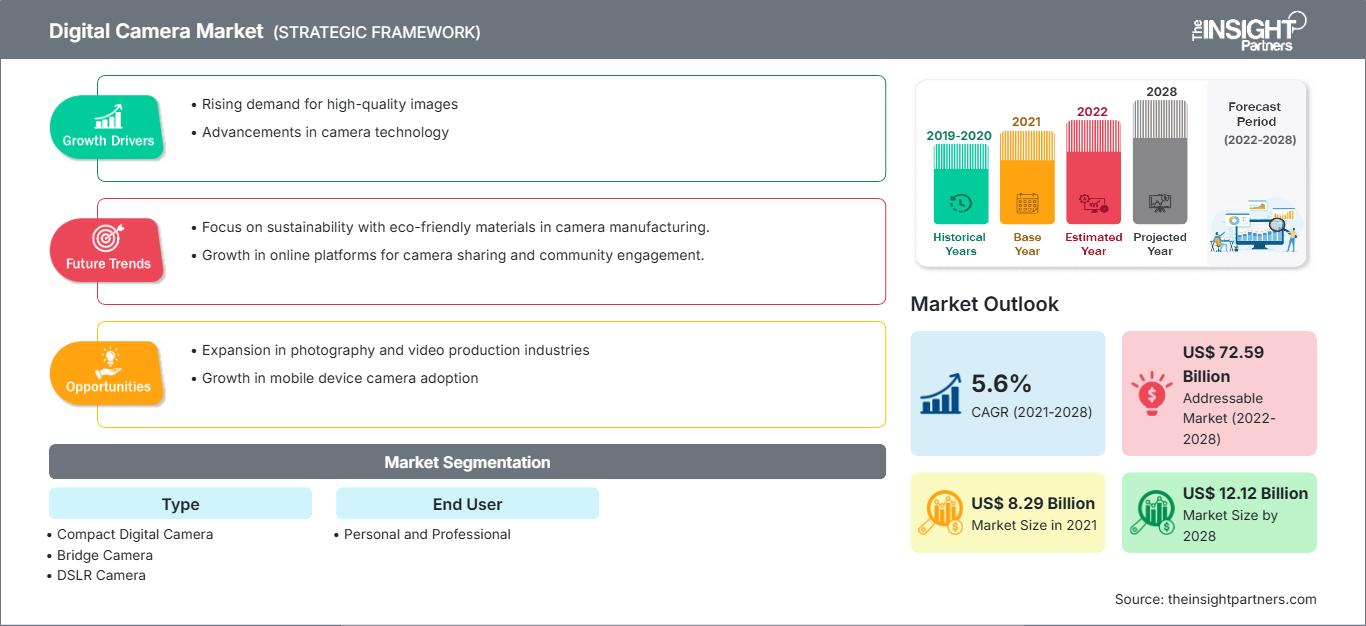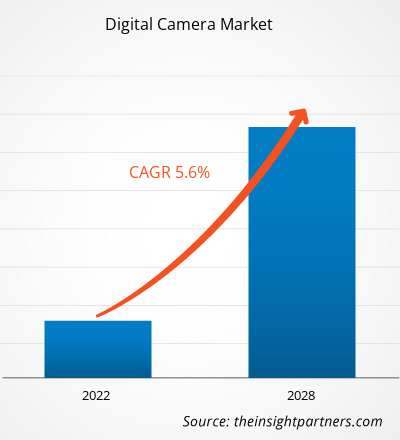デジタルカメラ市場は、2021年の82億9,025万米ドルから2028年には121億1,944万米ドルに成長すると予想されており、2021年から2028年にかけて5.6%のCAGRで成長すると推定されています。
デジタルカメラの使用は、個人やプロの写真撮影に限らず、エンターテイメント、メディア、スポーツ業界にも広がっています。映画産業は、世界のエンターテイメント業界で最大かつ最も収益性の高い分野の1つです。たとえば、中国の映画産業は世界最大級の映画産業の1つであり、2016年には約66億米ドルの収益を上げました。映画とエンターテイメント業界のこの有望な見通しは、完璧なショットやビデオを実現するためのデジタルカメラの需要を促進すると予想されます。急速な技術変化、消費者行動、ビジネスモデルにより、消費者がエンターテイメントやメディアを体験し、支払う方法が変化してきました。この業界のリーダーたちは、優れたコンテンツを制作するために、ファン重視のビジネスやブランドの構築に注力しています。そのため、コンピューター生成画像(CGI)や視覚効果(VFX)、そして高性能カメラといった技術や機器に多額の投資を行っています。また、スポーツメディアではデジタルカメラの使用が不可欠です。スタジアムにハイスピードカメラやデジタルカメラを設置することで、観客は試合の重要な局面でスローモーションリプレイを見ることができ、正確な映像で観戦することができます。同様に、野生動物、風景、建築物、スタジオ撮影において高解像度デジタルカメラを使用することで、鮮明で鮮明な画像や動画を撮影することができます。アクション写真への関心の高まりは、GoProなどのコンパクトデジタルカメラの需要を促進しています。さらに、Instagramなどのソーシャルメディアプラットフォームは写真撮影の範囲を大幅に拡大しており、デジタルカメラ市場の成長を加速させると予想されています。
要件に合わせてレポートをカスタマイズ
レポートの一部、国レベルの分析、Excelデータパックなどを含め、スタートアップ&大学向けに特別オファーや割引もご利用いただけます(無償)
デジタルカメラ市場: 戦略的洞察

-
このレポートの主要な市場動向を入手してください。この無料サンプルには、市場動向から見積もりや予測に至るまでのデータ分析が含まれます。
新型コロナウイルス感染症のパンデミックは、ロックダウン、渡航禁止、事業閉鎖などにより、各国の経済や産業に影響を及ぼしています。家電業界は、このパンデミックの影響でサプライチェーンの寸断、生産工場の閉鎖など、深刻な混乱に見舞われている主要産業の一つです。北米、欧州、アジア太平洋、南米、中東、アフリカなどの主要地域における様々な製造工場の閉鎖は、世界のサプライチェーンに影響を与え、様々な商品の製造、納期、販売に悪影響を及ぼしています。さらに、多くの企業が既に製品納入の遅延や今後の販売低迷の可能性を発表しています。さらに、欧州、アジア、北米諸国による世界的な渡航禁止措置は、ビジネスコラボレーションやパートナーシップの機会にも影響を与えています。これらの要因はすべて、家電業界に悪影響を及ぼし、今後数ヶ月間、この業界に関連する様々な市場の成長を抑制する要因となることが予想されます。デジタルカメラ市場は、生産不足と輸送施設の制限により、パンデミックの影響を受けています。
デジタルカメラ市場の洞察:デジタルカメラに関連する技術革新がデジタルカメラ市場の成長を促進
デジタルカメラ市場の枠組みは、HDやタッチスクリーンなど、革新的な技術開発と力強い進歩に支えられた新たな急進的なトレンドと密接に関連しています。長年にわたり、市場では、高度な写真撮影に対する消費者の傾向の高まりにより、デジタル一眼レフカメラとSLRカメラ市場の需要が高まっています。しかし、技術の進歩により、12~20メガピクセルを提供する高解像度カメラが開発されました。デジタルカメラの分野における継続的な進化により、より高い解像度、より速いフォーカス、さまざまな周辺機器のサポートを備えた高度なカメラが設計されています。また、スマートフォンに対する競争上の優位性を提供するために、デジタルカメラにWi-Fiまたは4Gモデムを組み込む傾向の増加も観察されています。さらに、こうしたカメラはIoT(モノのインターネット)などの複数の相互接続デバイスの一部となることが予想されており、近い将来、スマートフォンやスピーカーアシスタントなどの他の相互接続デバイスとの効率的な通信を可能にする可能性があります。
タイプ別市場分析
タイプ別に見ると、デジタルカメラ市場はコンパクトデジタルカメラ、ブリッジカメラ、デジタル一眼レフカメラ、ミラーレスカメラ、デジタルレンジファインダーカメラ、ラインスキャンカメラに分類されます。2020年には、デジタル一眼レフカメラセグメントが市場で最大のシェアを占めました。
デジタルカメラ市場の地域別分析
予測期間を通じてデジタルカメラ市場に影響を与える地域的なトレンドと要因については、The Insight Partnersのアナリストが詳細に解説しています。このセクションでは、北米、ヨーロッパ、アジア太平洋、中東・アフリカ、中南米におけるデジタルカメラ市場のセグメントと地域についても解説しています。
デジタルカメラ市場レポートの範囲
| レポート属性 | 詳細 |
|---|---|
| の市場規模 2021 | US$ 8.29 Billion |
| 市場規模別 2028 | US$ 12.12 Billion |
| 世界的なCAGR (2021 - 2028) | 5.6% |
| 過去データ | 2019-2020 |
| 予測期間 | 2022-2028 |
| 対象セグメント |
By タイプ
|
| 対象地域と国 |
北米
|
| 市場リーダーと主要企業の概要 |
|
デジタルカメラ市場におけるプレーヤーの密度:ビジネスダイナミクスへの影響を理解する
デジタルカメラ市場は、消費者の嗜好の変化、技術の進歩、製品メリットへの認知度の高まりといった要因によるエンドユーザー需要の高まりに牽引され、急速に成長しています。需要の増加に伴い、企業は製品ラインナップの拡充、消費者ニーズへの対応のための革新、そして新たなトレンドの活用を進めており、これが市場の成長をさらに加速させています。

- 入手 デジタルカメラ市場 主要プレーヤーの概要
用途別に見ると、デジタルカメラ市場は個人用とプロ用に分かれています。2020年には、プロ用セグメントがより大きな市場シェアを占めました。
デジタル市場で事業を展開する企業は、合併、買収、市場開拓といった戦略を採用し、市場での地位を維持しています。主要企業による動向をいくつかご紹介します。
- 富士フイルムホールディングス株式会社は、2021年2月下旬にFUJIFILM GFX100Sを発売すると発表しました。このカメラは、ミラーレスデジタルカメラGFXシリーズの最新作です。
- ニコン株式会社は、フルサイズミラーレスカメラZ 7IIを発売しました。Z 7IIは、フルサイズの高解像度ミラーレスカメラです。こうした製品の発売を通じて、同社は映像文化の発展に貢献しています。
デジタルカメラ市場は、次のように区分されています。
タイプ別
- コンパクトデジタルカメラ
- ブリッジカメラ
- DSLRカメラ
- ミラーレスカメラ
- デジタルレンジファインダーカメラ
- ラインスキャンカメラ
エンドユーザー別
- 個人用
- プロフェッショナル用
地域別
-
北米アメリカ
- 米国
- カナダ
- メキシコ
-
ヨーロッパ
- フランス
- ドイツ
- イタリア
- 英国
- ロシア
- その他のヨーロッパ
-
アジア太平洋 (APAC)
- 中国
- インド
- 韓国
- 日本
- オーストラリア
- その他の APAC
-
中東 &アフリカ(MEA)
- 南アフリカ
- サウジアラビア
- UAE
- MEAのその他の地域
-
南米(SAM)
- ブラジル
- アルゼンチン
- SAMのその他の地域
企業プロフィール
- キヤノン株式会社
- イーストマン・コダック社
- 富士フイルムホールディングス株式会社
- ライカカメラAG
- 株式会社ニコン
- OMデジタルソリューションズ株式会社
- パナソニック株式会社
- ハッセルブラッド
- リコーイメージング株式会社
- ソニー株式会社
- 過去2年間の分析、基準年、CAGRによる予測(7年間)
- PEST分析とSWOT分析
- 市場規模価値/数量 - 世界、地域、国
- 業界と競争環境
- Excel データセット
最新レポート
関連レポート
お客様の声
購入理由
- 情報に基づいた意思決定
- 市場動向の理解
- 競合分析
- 顧客インサイト
- 市場予測
- リスク軽減
- 戦略計画
- 投資の正当性
- 新興市場の特定
- マーケティング戦略の強化
- 業務効率の向上
- 規制動向への対応






















 無料サンプルを入手 - デジタルカメラ市場
無料サンプルを入手 - デジタルカメラ市場